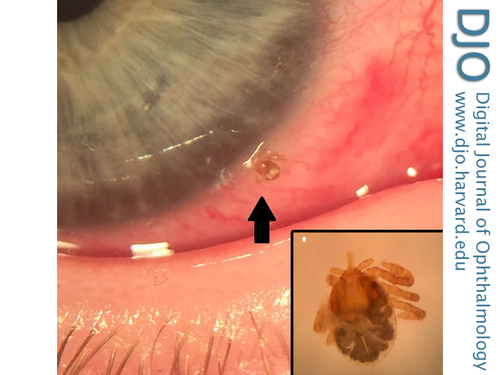
 |
 |
 |

Register
with DJO to receive personalized updates.
If you're already a
member, please sign in.
|
 |
 |
|
 |
 |
 |
 |
Conjunctival tick bite Nov 28, 2016 Volume 22, Number 4 Casey Beal, MD, FAAP | Department of Ophthalmology, University of Florida College of Medicine, Gainesville Fouad El Sayyad, MD | Department of Ophthalmology, University of Florida College of Medicine, Gainesville Jeffrey Hertz, PhD | Entomology and Nematology Department, University of Florida, Gainesville  A 3-year-old girl presented to the Department of Ophthalmology, University of Florida, with a 3-day history of redness of the right eye and a foreign body. She had no other systemic symptoms and no past ocular history. Examination revealed uncorrected distance visual acuity of 20/25 in each eye. On slit-lamp examination, she was found to have a tick that measured 1.0 mm in length embedded in her conjunctiva adjacent to the nasal limbus with associated conjunctival injection. The remainder of the examination was unremarkable, with no intraocular inflammation, skin rashes, or lymphadenopathy. The tick was surgically removed in the operating room. The patient was started on topical moxifloxacin eyedrops and followed in clinic with complete resolution of conjunctival injection and symptoms. She did not develop any systemic symptoms including fever, chills, rashes, or lymphadenopathy. The tick was identified at the University of Florida Department of Entomology and Nematology as a lone star tick (Amblyomma americanum) in the larval stage (inset). The lone star tick does not transmit Borrelia burgdorferi, the pathogen most commonly associated with Lyme disease, but it may transmit several diseases that affect humans, including ehrlichiosis, rickettsiosis, and tularemia. |
 |
 |
 |

|
|
 Welcome, please sign in
Welcome, please sign in  Welcome, please sign in
Welcome, please sign in